Pictorial Travel Around the Continents
Memory of the mid-twentieth century - 1950 circa
Texto extraído do verso das Estampas
Das Coleções do Rio de Janeiro
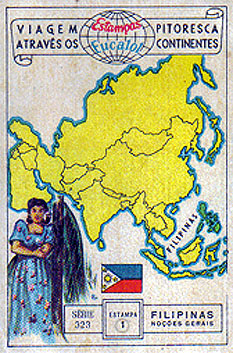
FILIPINAS – NOÇÕES GERAIS
Importante arquipélago situado no Mar da China, as Filipinas tèm 299.000 km2, e 19.300.000 habitantes. O clima é úmido e quente, as ilhas principais são Mindanao, Lução, Samar e Negros, e a capital é Manila. Antiga colônia espanhola, as Filipinas foram cedidas aos Estados Unidos em 1918, e proclamaram sua independência em 1946.
PHILIPPINES - GENERAL CONCEPTS
Important
archipelago located in the Sea of China, the Philippines tèm
299,000 km2, and 19,300,000 inhabitants. The climate is hot and humid,
the main islands are Mindanao, Luca, Samar and Negros, and the capital
is Manila. Former Spanish colony, the Philippines were ceded to the
United States in 1918, and proclaimed its independence in 1946.
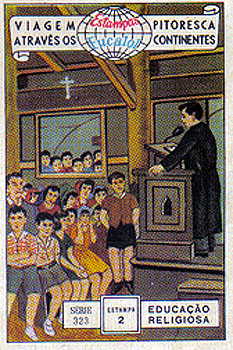
EDUCAÇÃO RELIGIOSA
Os Filipinos, de origens diversas, são em grande maioria católicos. Graças à influência cristã e à penetração cada vez maior da civilização norte-americana, o povo filipino distingue-se dos outros povos asiáticos por ter uma proporção mínima de analfabetos e possuir um elevado estatuto social da mulher.
RELIGIOUS EDUCATION
The Filipinos, from different backgrounds, are in most Catholics. Thanks
to the Christian influence and the increasing penetration of the American
civilization, the Filipino people is different from the other Asian
nations to have a minimum proportion of illiterate and have a high social
status of women. (brasilcult)
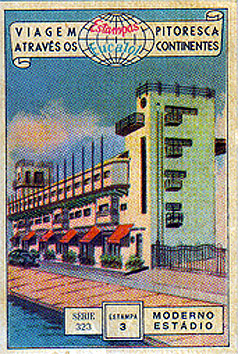
MODERNO ESTÁDIO
Este estádio modern em Manila, capital do país, mostra a penetração da civilização ocidental. Os esportes e jogos norte-americanos foram adaptados com entusiasmo pelos filipinos, a título de divertimento bem como de desenvolvimento físico.
MODERN STADIUM
This modern stadium in Manila, capital of the country, shows the penetration
of Western civilization. The sports and games North Americans have been
adapted with enthusiasm by Filipinos, for fun as well as physical development.
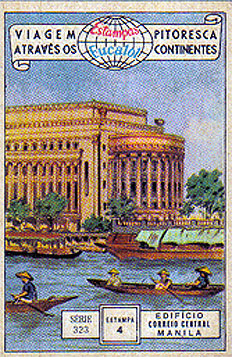
EDIFÍCIO CORREIO CENTRAL – MANILA
Manila é uma cidade deslumbrante, conhecida pelo apelido de “Pérola do Oriente”. Estende seus lindos jardins, suas largas avenidas e seus ricos edifícios, nas duas beiras do rio Pasig. Eis aqui o Correio Central, visto do rio.
CENTRAL BUILDING MAIL - MANILA
Manila is a stunning city, known by the nickname of "Pearl of the Orient". Extends its beautiful gardens, its broad avenues and its rich buildings, the two borders of the Pasig River. Here is the Post Office, seen from the river.

PORTO DE MANILA
É tipicamente oriental o porto de Manila. Situado no cruzamento das principais rotas do Pacífico, foi, desde o século XV, o centro de uma intensiva atividadde marítima e comercial. A sua população pe de várias origens, inclusive os descendentes dos antigos piratas mouros.
PORT OF MANILA
It
is typically the eastern port of Manila. Situated at the crossroads
of the main routes of the Pacific, was from the fifteenth century, the
center of an intensive atividadde shipping and trade. Its small population
from various sources, including the descendants of the old Moorish pirates.
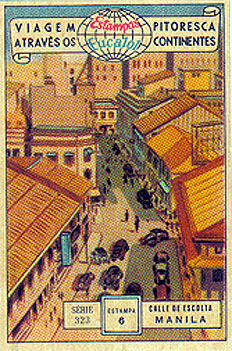
CALLE DE ESCOLTA – MANILA
A calle de Escolta é a rua principal de Manila. Esta linda cidade conta atualmente mais de 1 milhão de habitantes. Na beira sul do Rio Pasig, dentro das antigas fortificações, é situada a parte mais antiga de Manila. Lá se encontram os principais edifícios públicos, a Universidade, o Observatório, a Catedral, escolas e conventos.
CALLE DE ESCOLTA - MANILA
The Calle de Escolta the main street of Manila. This beautiful city
has currently more than 1 million inhabitants. In the southern edge
of Pasig River, inside the ancient fortifications, is situated the oldest
part of Manila. Here are the main public buildings, the University,
the Observatory, the Cathedral, schools and convents.
[Cultura] [Mapa
do Site]
![]()